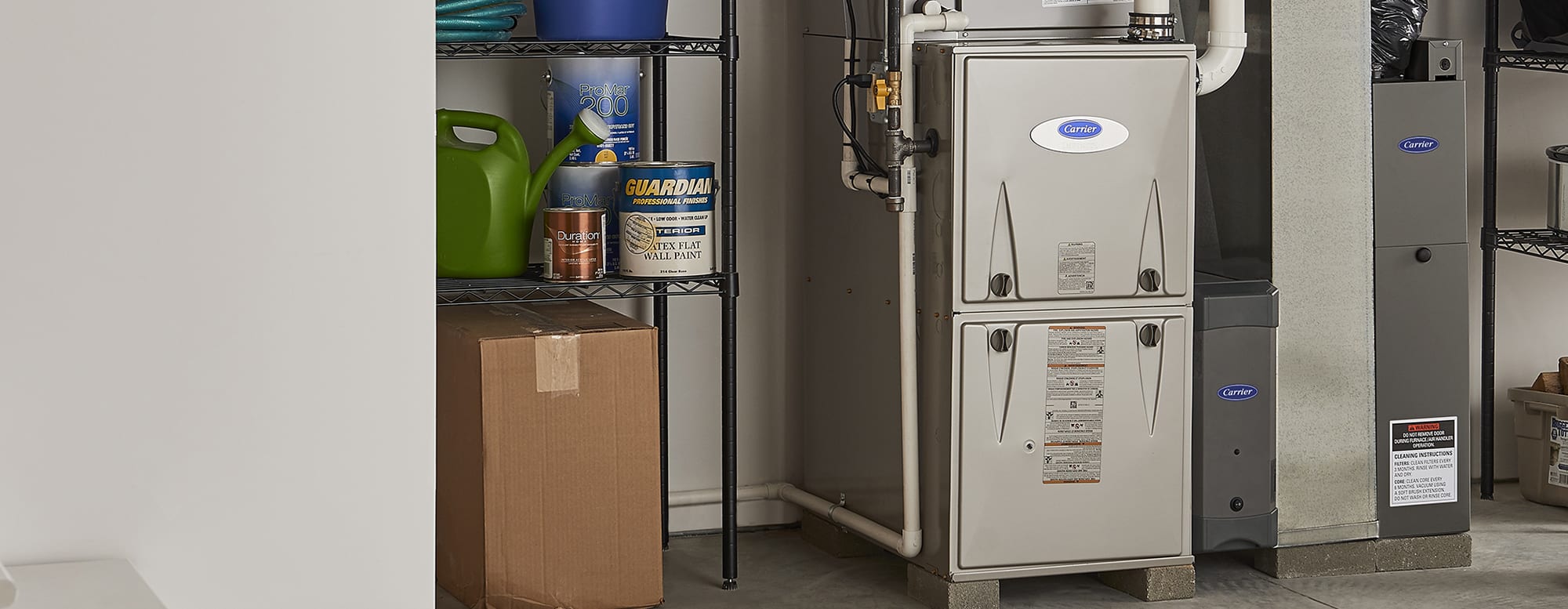Carrier Gas Furnaces
Natural gas is the most widely accepted heating fuel for U.S. heating systems, and Carrier gas furnaces are among the finest. And while most people know that a gas furnace provides heat for their homes, they may not fully appreciate how important it can be for indoor comfort all year long.
With a powerful, centralized blower that circulates air throughout the home, gas furnaces are often the foundation of a complete HVAC system. Combined with an air conditioner or heat pump and accessories like a whole-home air purifier, humidifier, UV germicidal lights and even whole-home fresh air ventilation, they are the command center for both comfort and improved indoor air quality.
With a little insight into how a gas furnace works and how to choose one that best fits your needs, you can expect your new heating system to provide years of dependable home comfort.

How Does a Gas Heat Furnace Work?
Unlike heat pumps, which move heat energy from an outside source to indoor air, a gas heat furnace heats air using combustion. This is why it can deliver efficient comfort when outdoor temperatures drop – times when traditional air-source heat pumps become less energy efficient.
Here’s how it works: Natural gas is piped into the furnace where it is burned in a sealed chamber. Heat output from combustion is captured by a metal heating element called a heat exchanger inside the furnace. At the same time, a powerful fan blows cool indoor air across the heat exchanger to absorb the heat. That air circulates back to your home through ductwork to create a comfortable stream of heated air into your living spaces.
Today’s natural gas furnaces are very energy efficient. Gas furnace efficiency is expressed using AFUE ratings. AFUE, or Annual Fuel Utilization Efficiency, tells you what percentage of the natural gas used is converted to heat. Highly efficient furnaces with AFUE ratings in the mid to high nineties achieve those ratings with higher-end components like variable speed motors, “smart” control boards, and multi-stage gas valves. Currently, the minimum AFUE for a natural gas furnace is 80%, while the Carrier ® Infinity 98 gas furnace with Greenspeed® Intelligence offers up to 98.5% AFUE efficiency.
Choosing the Best Gas Furnace
When it comes to furnaces, you have a lot of choices! Starting with fuel source options, there are natural gas furnaces, oil furnaces, propane furnaces and electric furnaces. Assuming your heating system uses natural gas, here are pointers for finding the best gas furnace for your home.
A big consideration will be your budget. The highest efficiency, ENERGY STAR® certified models can save on heating bills for years, and many include comfort-enhancing features. They can also be much more expensive than a basic model that meets the government's minimum efficiency rating. If you stretch your budget with the highest efficiency model you can afford, you may just get a little money back in rebates or tax credits.
A high quality gas furnace from a reputable manufacturer will probably last longer and operate more reliably than a cut-rate model. For example, Carrier gas furnaces are 100% run tested at the factory. Each furnace must successfully pass our full battery of operation and reliability testing before it can leave the manufacturing facility, with no exceptions.
Customer reviews are usually available on the internet and can provide some sense of whether a certain model or brand has recurring quality issues – or which ones are better than others. Recommendations from family members, friends or neighbors can be helpful as well.
Finally, to make sure the furnace you like is a good fit for your home, securing a recommendation from your trusted local HVAC professional can be a great way to confirm your choice.

Is a Gas Furnace Cheaper Than an Electric Furnace?
In general, most sources quote the average price for an electric furnace, with installation costs included, to be lower than the price of a gas furnace. One reason for the price differential is that gas furnaces include several components not required for an electric model. Gas furnaces include a gas valve, burners, an ignitor, a flame sensor and heat exchanger not included on an electric model. Venting required for a gas furnace can add gas furnace cost as well.
However, it’s also important to keep lifetime operating costs and your local climate in mind before you decide. Electric furnaces are more popular in southern and southwestern states where heating seasons are shorter and less intense. In northern climates where gas furnaces are more common, heating seasons are longer and temperatures are more extreme. And while costs can vary, fuel costs for heating a home with gas are generally lower than costs associated with an electric furnace.
Find a Carrier Gas Furnace Expert
Finding the perfect gas furnace for your home can be a daunting experience. From finding the right model, to making sure it has the heating capacity to keep your entire home comfortable and is installed correctly, there’s a lot to consider! That’s why soliciting advice from an expert can be comforting.
Carrier’s gas furnace qualified experts can help you navigate through the process. They have the experience and training to assess your home, evaluate your needs, and provide recommendations that make sense for your budget. It’s a choice that can affect your comfort and your wallet for years to come. If you don’t already have one in mind, you can find a Carrier Expert using our convenient dealer locator on our residential products website.
- Read about gas furnace repair
- What’s involved with gas furnace replacement

